Gender Disparity in Education: Female Students' Stream Choice Analysis
VerifiedAdded on 2023/05/06
|100
|30026
|82
Report
AI Summary
This report investigates the stream choices and academic performance of female students in secondary and preparatory schools within the Gamo Gofa Zone, Ethiopia. The study explores the underrepresentation of girls in science and technology, highlighting the preference for social science streams and the resulting gender imbalance in the labor force. The research addresses the influence of cultural, school, and home factors on female students' choices, as well as the impact of teachers, peers, and learning materials. It examines the attitudes of female students towards their stream choices, identifies factors affecting their choices, and assesses their academic performance. The report aims to identify strategies to improve girls' participation in various fields and provides insights for educators, policymakers, and parents to address gender disparities and promote balanced educational opportunities.
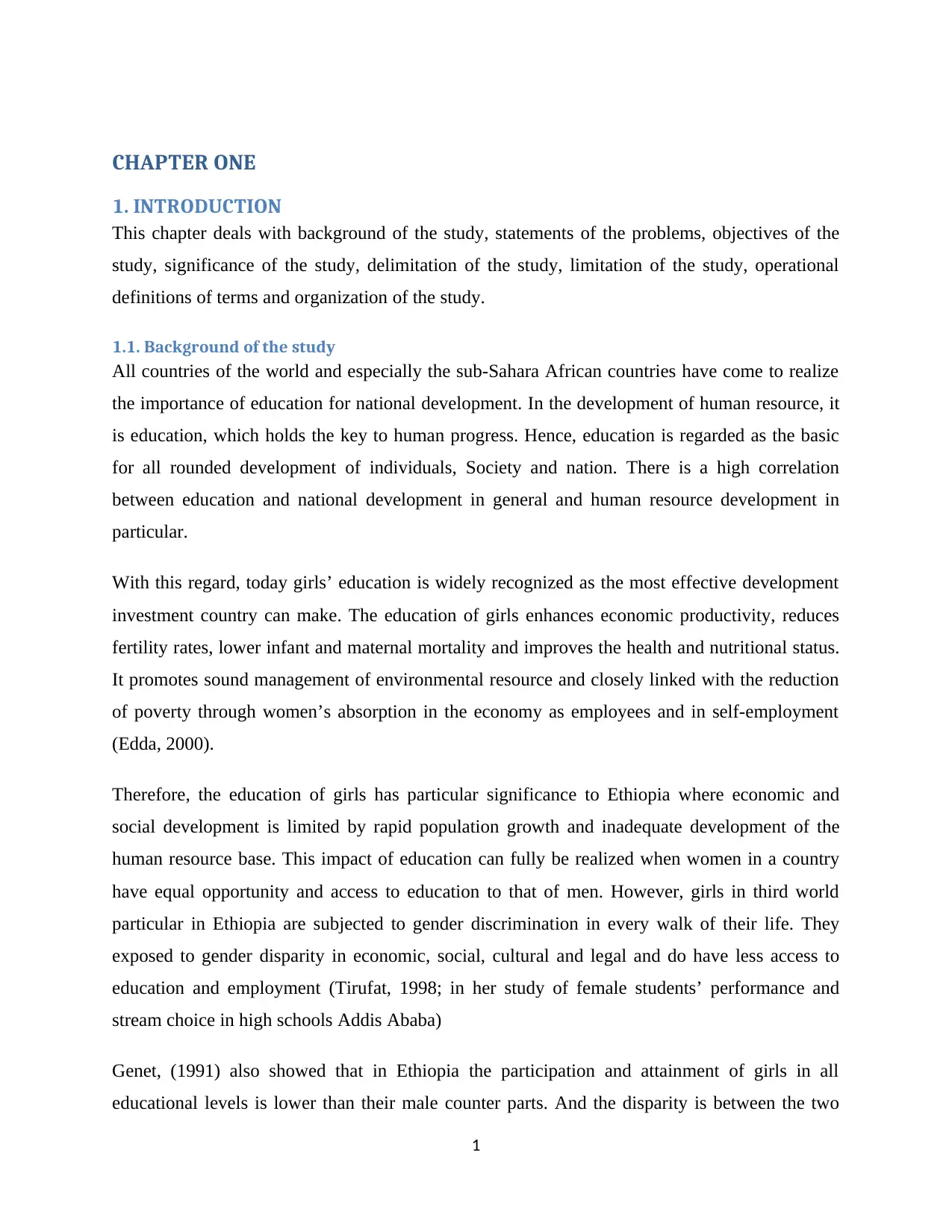
CHAPTER ONE
1. INTRODUCTION
This chapter deals with background of the study, statements of the problems, objectives of the
study, significance of the study, delimitation of the study, limitation of the study, operational
definitions of terms and organization of the study.
1.1. Background of the study
All countries of the world and especially the sub-Sahara African countries have come to realize
the importance of education for national development. In the development of human resource, it
is education, which holds the key to human progress. Hence, education is regarded as the basic
for all rounded development of individuals, Society and nation. There is a high correlation
between education and national development in general and human resource development in
particular.
With this regard, today girls’ education is widely recognized as the most effective development
investment country can make. The education of girls enhances economic productivity, reduces
fertility rates, lower infant and maternal mortality and improves the health and nutritional status.
It promotes sound management of environmental resource and closely linked with the reduction
of poverty through women’s absorption in the economy as employees and in self-employment
(Edda, 2000).
Therefore, the education of girls has particular significance to Ethiopia where economic and
social development is limited by rapid population growth and inadequate development of the
human resource base. This impact of education can fully be realized when women in a country
have equal opportunity and access to education to that of men. However, girls in third world
particular in Ethiopia are subjected to gender discrimination in every walk of their life. They
exposed to gender disparity in economic, social, cultural and legal and do have less access to
education and employment (Tirufat, 1998; in her study of female students’ performance and
stream choice in high schools Addis Ababa)
Genet, (1991) also showed that in Ethiopia the participation and attainment of girls in all
educational levels is lower than their male counter parts. And the disparity is between the two
1
1. INTRODUCTION
This chapter deals with background of the study, statements of the problems, objectives of the
study, significance of the study, delimitation of the study, limitation of the study, operational
definitions of terms and organization of the study.
1.1. Background of the study
All countries of the world and especially the sub-Sahara African countries have come to realize
the importance of education for national development. In the development of human resource, it
is education, which holds the key to human progress. Hence, education is regarded as the basic
for all rounded development of individuals, Society and nation. There is a high correlation
between education and national development in general and human resource development in
particular.
With this regard, today girls’ education is widely recognized as the most effective development
investment country can make. The education of girls enhances economic productivity, reduces
fertility rates, lower infant and maternal mortality and improves the health and nutritional status.
It promotes sound management of environmental resource and closely linked with the reduction
of poverty through women’s absorption in the economy as employees and in self-employment
(Edda, 2000).
Therefore, the education of girls has particular significance to Ethiopia where economic and
social development is limited by rapid population growth and inadequate development of the
human resource base. This impact of education can fully be realized when women in a country
have equal opportunity and access to education to that of men. However, girls in third world
particular in Ethiopia are subjected to gender discrimination in every walk of their life. They
exposed to gender disparity in economic, social, cultural and legal and do have less access to
education and employment (Tirufat, 1998; in her study of female students’ performance and
stream choice in high schools Addis Ababa)
Genet, (1991) also showed that in Ethiopia the participation and attainment of girls in all
educational levels is lower than their male counter parts. And the disparity is between the two
1
Paraphrase This Document
Need a fresh take? Get an instant paraphrase of this document with our AI Paraphraser
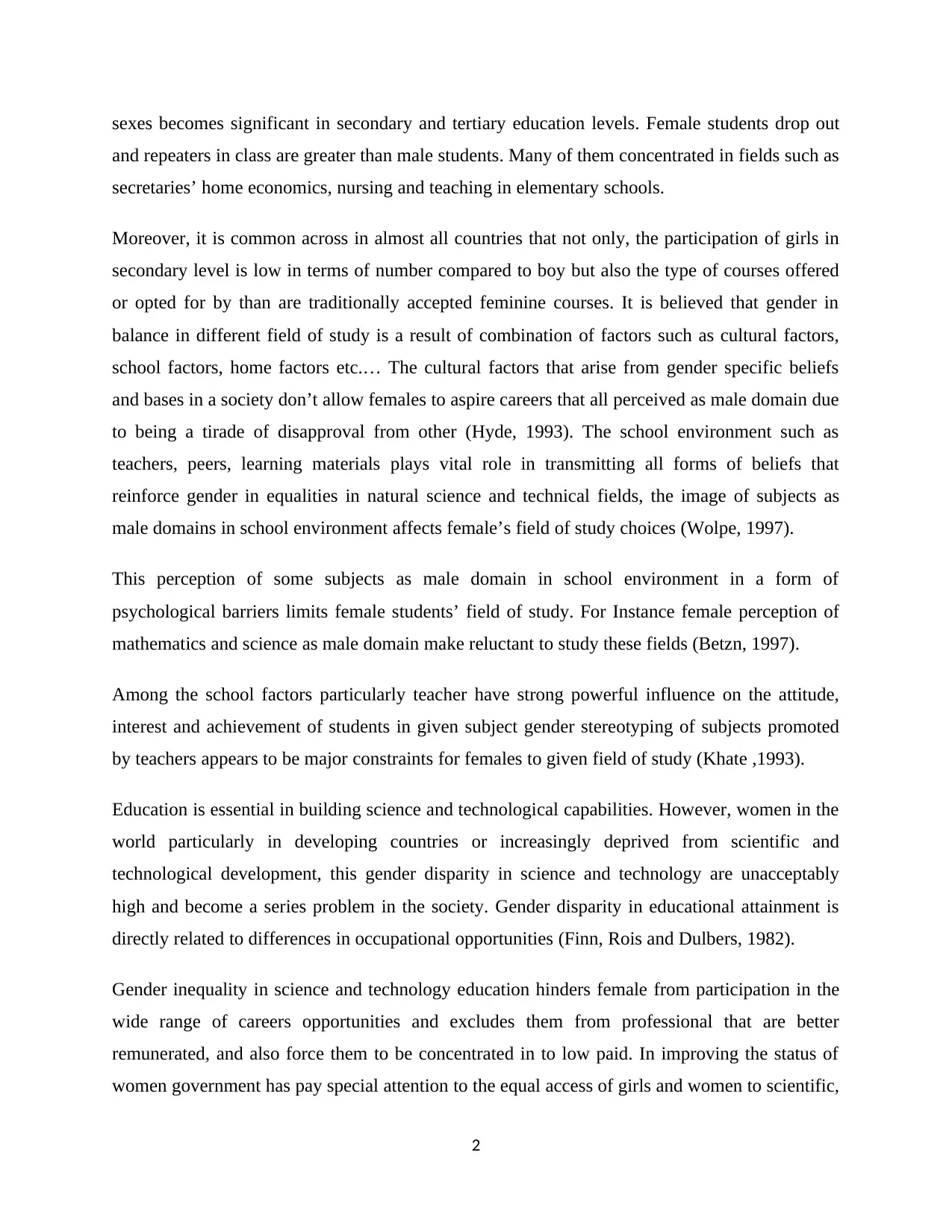
sexes becomes significant in secondary and tertiary education levels. Female students drop out
and repeaters in class are greater than male students. Many of them concentrated in fields such as
secretaries’ home economics, nursing and teaching in elementary schools.
Moreover, it is common across in almost all countries that not only, the participation of girls in
secondary level is low in terms of number compared to boy but also the type of courses offered
or opted for by than are traditionally accepted feminine courses. It is believed that gender in
balance in different field of study is a result of combination of factors such as cultural factors,
school factors, home factors etc.… The cultural factors that arise from gender specific beliefs
and bases in a society don’t allow females to aspire careers that all perceived as male domain due
to being a tirade of disapproval from other (Hyde, 1993). The school environment such as
teachers, peers, learning materials plays vital role in transmitting all forms of beliefs that
reinforce gender in equalities in natural science and technical fields, the image of subjects as
male domains in school environment affects female’s field of study choices (Wolpe, 1997).
This perception of some subjects as male domain in school environment in a form of
psychological barriers limits female students’ field of study. For Instance female perception of
mathematics and science as male domain make reluctant to study these fields (Betzn, 1997).
Among the school factors particularly teacher have strong powerful influence on the attitude,
interest and achievement of students in given subject gender stereotyping of subjects promoted
by teachers appears to be major constraints for females to given field of study (Khate ,1993).
Education is essential in building science and technological capabilities. However, women in the
world particularly in developing countries or increasingly deprived from scientific and
technological development, this gender disparity in science and technology are unacceptably
high and become a series problem in the society. Gender disparity in educational attainment is
directly related to differences in occupational opportunities (Finn, Rois and Dulbers, 1982).
Gender inequality in science and technology education hinders female from participation in the
wide range of careers opportunities and excludes them from professional that are better
remunerated, and also force them to be concentrated in to low paid. In improving the status of
women government has pay special attention to the equal access of girls and women to scientific,
2
and repeaters in class are greater than male students. Many of them concentrated in fields such as
secretaries’ home economics, nursing and teaching in elementary schools.
Moreover, it is common across in almost all countries that not only, the participation of girls in
secondary level is low in terms of number compared to boy but also the type of courses offered
or opted for by than are traditionally accepted feminine courses. It is believed that gender in
balance in different field of study is a result of combination of factors such as cultural factors,
school factors, home factors etc.… The cultural factors that arise from gender specific beliefs
and bases in a society don’t allow females to aspire careers that all perceived as male domain due
to being a tirade of disapproval from other (Hyde, 1993). The school environment such as
teachers, peers, learning materials plays vital role in transmitting all forms of beliefs that
reinforce gender in equalities in natural science and technical fields, the image of subjects as
male domains in school environment affects female’s field of study choices (Wolpe, 1997).
This perception of some subjects as male domain in school environment in a form of
psychological barriers limits female students’ field of study. For Instance female perception of
mathematics and science as male domain make reluctant to study these fields (Betzn, 1997).
Among the school factors particularly teacher have strong powerful influence on the attitude,
interest and achievement of students in given subject gender stereotyping of subjects promoted
by teachers appears to be major constraints for females to given field of study (Khate ,1993).
Education is essential in building science and technological capabilities. However, women in the
world particularly in developing countries or increasingly deprived from scientific and
technological development, this gender disparity in science and technology are unacceptably
high and become a series problem in the society. Gender disparity in educational attainment is
directly related to differences in occupational opportunities (Finn, Rois and Dulbers, 1982).
Gender inequality in science and technology education hinders female from participation in the
wide range of careers opportunities and excludes them from professional that are better
remunerated, and also force them to be concentrated in to low paid. In improving the status of
women government has pay special attention to the equal access of girls and women to scientific,
2
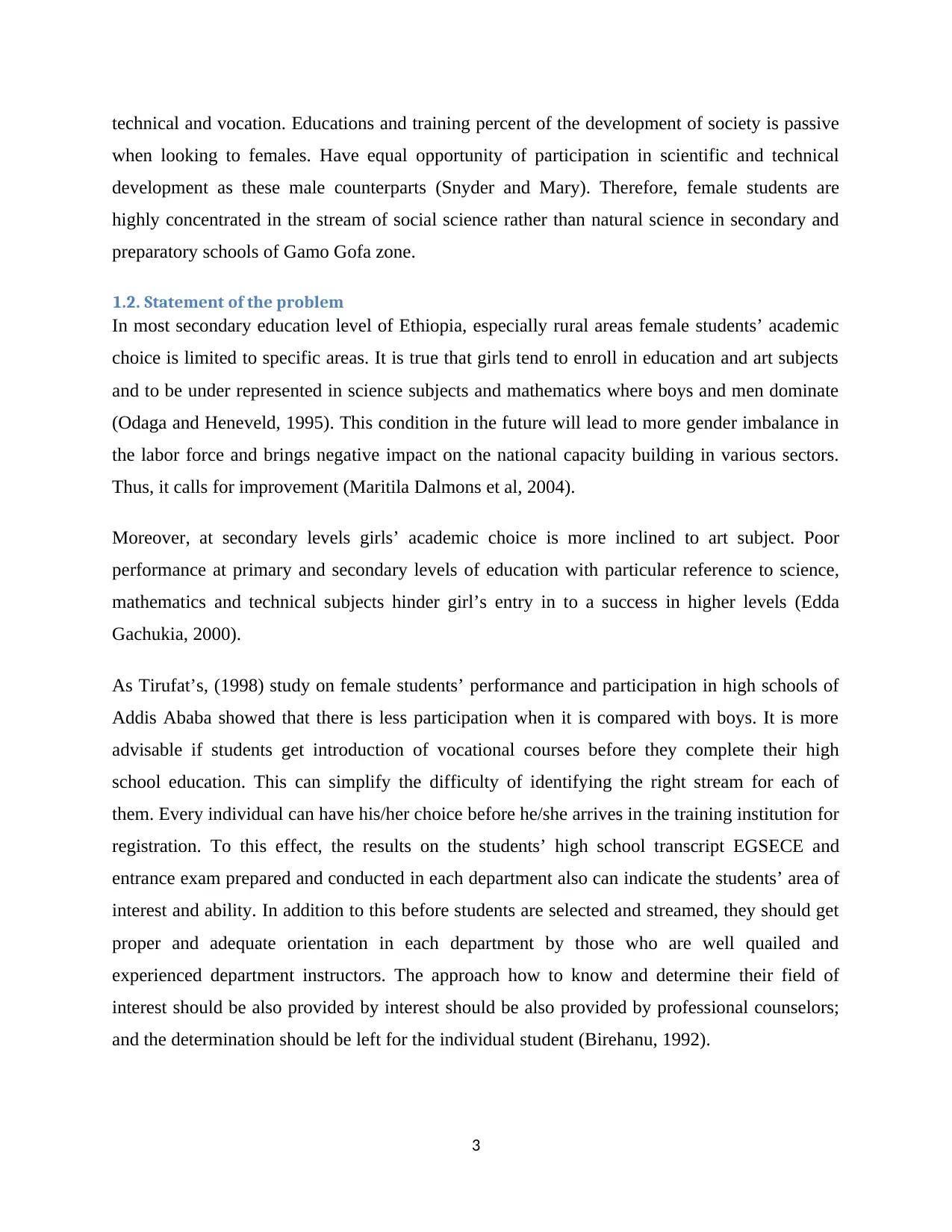
technical and vocation. Educations and training percent of the development of society is passive
when looking to females. Have equal opportunity of participation in scientific and technical
development as these male counterparts (Snyder and Mary). Therefore, female students are
highly concentrated in the stream of social science rather than natural science in secondary and
preparatory schools of Gamo Gofa zone.
1.2. Statement of the problem
In most secondary education level of Ethiopia, especially rural areas female students’ academic
choice is limited to specific areas. It is true that girls tend to enroll in education and art subjects
and to be under represented in science subjects and mathematics where boys and men dominate
(Odaga and Heneveld, 1995). This condition in the future will lead to more gender imbalance in
the labor force and brings negative impact on the national capacity building in various sectors.
Thus, it calls for improvement (Maritila Dalmons et al, 2004).
Moreover, at secondary levels girls’ academic choice is more inclined to art subject. Poor
performance at primary and secondary levels of education with particular reference to science,
mathematics and technical subjects hinder girl’s entry in to a success in higher levels (Edda
Gachukia, 2000).
As Tirufat’s, (1998) study on female students’ performance and participation in high schools of
Addis Ababa showed that there is less participation when it is compared with boys. It is more
advisable if students get introduction of vocational courses before they complete their high
school education. This can simplify the difficulty of identifying the right stream for each of
them. Every individual can have his/her choice before he/she arrives in the training institution for
registration. To this effect, the results on the students’ high school transcript EGSECE and
entrance exam prepared and conducted in each department also can indicate the students’ area of
interest and ability. In addition to this before students are selected and streamed, they should get
proper and adequate orientation in each department by those who are well quailed and
experienced department instructors. The approach how to know and determine their field of
interest should be also provided by interest should be also provided by professional counselors;
and the determination should be left for the individual student (Birehanu, 1992).
3
when looking to females. Have equal opportunity of participation in scientific and technical
development as these male counterparts (Snyder and Mary). Therefore, female students are
highly concentrated in the stream of social science rather than natural science in secondary and
preparatory schools of Gamo Gofa zone.
1.2. Statement of the problem
In most secondary education level of Ethiopia, especially rural areas female students’ academic
choice is limited to specific areas. It is true that girls tend to enroll in education and art subjects
and to be under represented in science subjects and mathematics where boys and men dominate
(Odaga and Heneveld, 1995). This condition in the future will lead to more gender imbalance in
the labor force and brings negative impact on the national capacity building in various sectors.
Thus, it calls for improvement (Maritila Dalmons et al, 2004).
Moreover, at secondary levels girls’ academic choice is more inclined to art subject. Poor
performance at primary and secondary levels of education with particular reference to science,
mathematics and technical subjects hinder girl’s entry in to a success in higher levels (Edda
Gachukia, 2000).
As Tirufat’s, (1998) study on female students’ performance and participation in high schools of
Addis Ababa showed that there is less participation when it is compared with boys. It is more
advisable if students get introduction of vocational courses before they complete their high
school education. This can simplify the difficulty of identifying the right stream for each of
them. Every individual can have his/her choice before he/she arrives in the training institution for
registration. To this effect, the results on the students’ high school transcript EGSECE and
entrance exam prepared and conducted in each department also can indicate the students’ area of
interest and ability. In addition to this before students are selected and streamed, they should get
proper and adequate orientation in each department by those who are well quailed and
experienced department instructors. The approach how to know and determine their field of
interest should be also provided by interest should be also provided by professional counselors;
and the determination should be left for the individual student (Birehanu, 1992).
3
⊘ This is a preview!⊘
Do you want full access?
Subscribe today to unlock all pages.

Trusted by 1+ million students worldwide
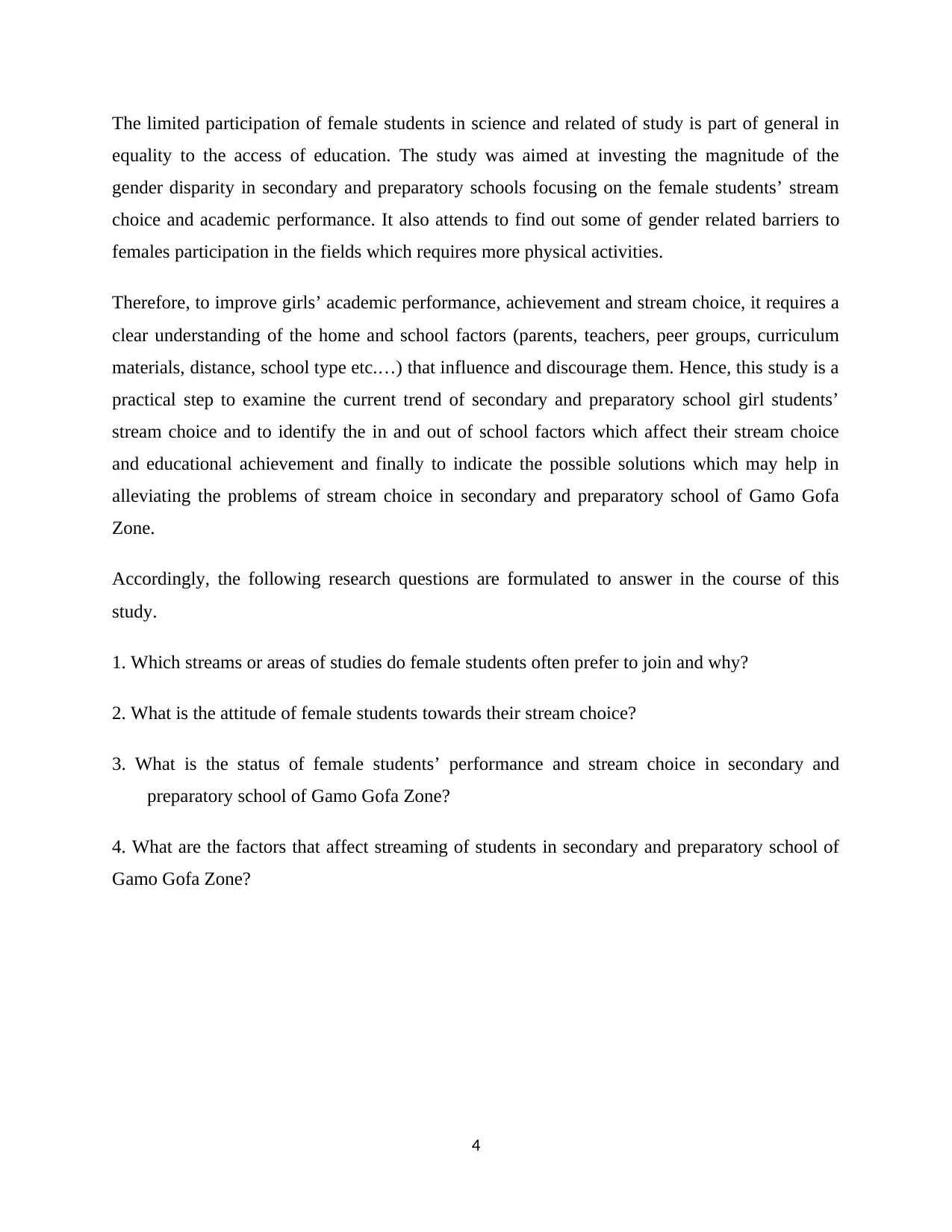
The limited participation of female students in science and related of study is part of general in
equality to the access of education. The study was aimed at investing the magnitude of the
gender disparity in secondary and preparatory schools focusing on the female students’ stream
choice and academic performance. It also attends to find out some of gender related barriers to
females participation in the fields which requires more physical activities.
Therefore, to improve girls’ academic performance, achievement and stream choice, it requires a
clear understanding of the home and school factors (parents, teachers, peer groups, curriculum
materials, distance, school type etc.…) that influence and discourage them. Hence, this study is a
practical step to examine the current trend of secondary and preparatory school girl students’
stream choice and to identify the in and out of school factors which affect their stream choice
and educational achievement and finally to indicate the possible solutions which may help in
alleviating the problems of stream choice in secondary and preparatory school of Gamo Gofa
Zone.
Accordingly, the following research questions are formulated to answer in the course of this
study.
1. Which streams or areas of studies do female students often prefer to join and why?
2. What is the attitude of female students towards their stream choice?
3. What is the status of female students’ performance and stream choice in secondary and
preparatory school of Gamo Gofa Zone?
4. What are the factors that affect streaming of students in secondary and preparatory school of
Gamo Gofa Zone?
4
equality to the access of education. The study was aimed at investing the magnitude of the
gender disparity in secondary and preparatory schools focusing on the female students’ stream
choice and academic performance. It also attends to find out some of gender related barriers to
females participation in the fields which requires more physical activities.
Therefore, to improve girls’ academic performance, achievement and stream choice, it requires a
clear understanding of the home and school factors (parents, teachers, peer groups, curriculum
materials, distance, school type etc.…) that influence and discourage them. Hence, this study is a
practical step to examine the current trend of secondary and preparatory school girl students’
stream choice and to identify the in and out of school factors which affect their stream choice
and educational achievement and finally to indicate the possible solutions which may help in
alleviating the problems of stream choice in secondary and preparatory school of Gamo Gofa
Zone.
Accordingly, the following research questions are formulated to answer in the course of this
study.
1. Which streams or areas of studies do female students often prefer to join and why?
2. What is the attitude of female students towards their stream choice?
3. What is the status of female students’ performance and stream choice in secondary and
preparatory school of Gamo Gofa Zone?
4. What are the factors that affect streaming of students in secondary and preparatory school of
Gamo Gofa Zone?
4
Paraphrase This Document
Need a fresh take? Get an instant paraphrase of this document with our AI Paraphraser
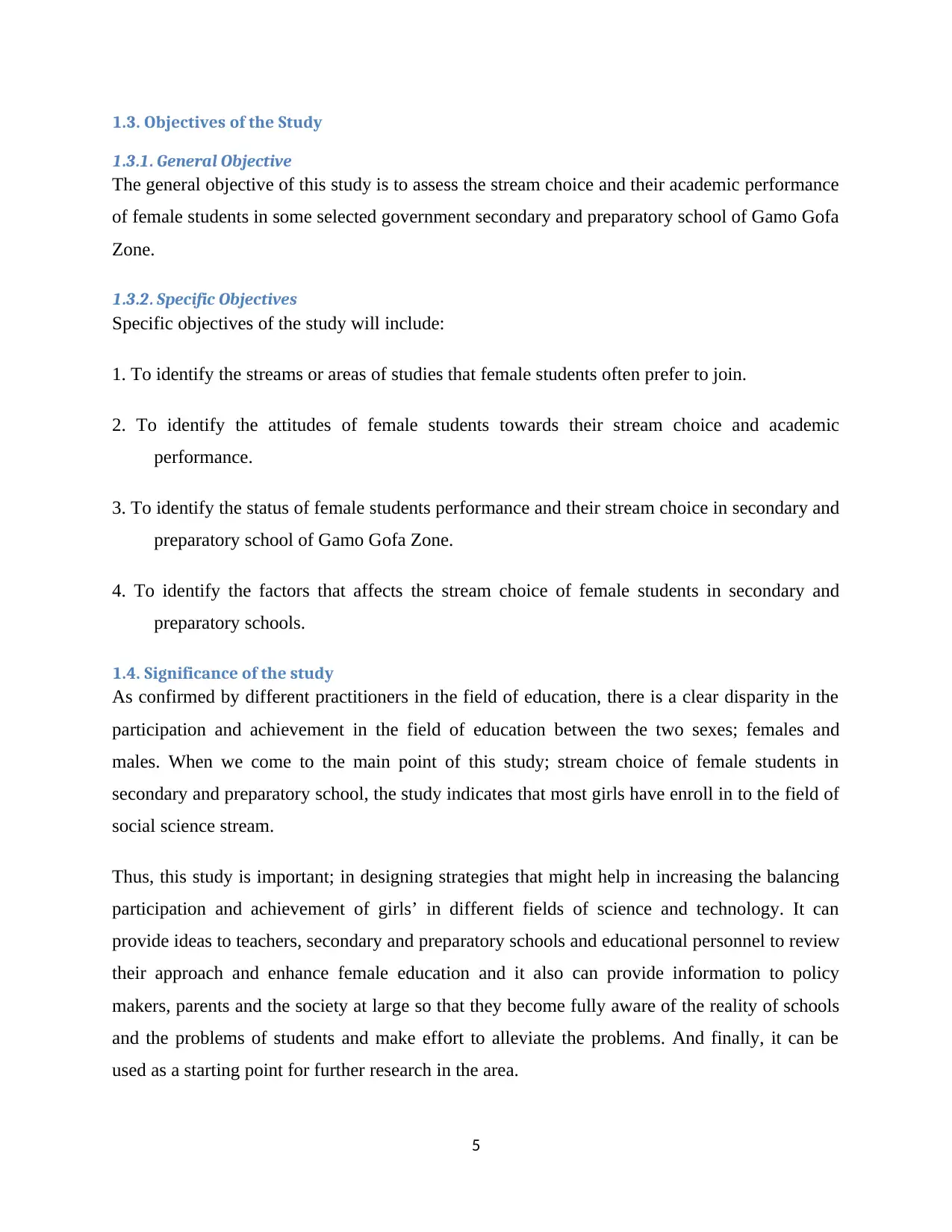
1.3. Objectives of the Study
1.3.1. General Objective
The general objective of this study is to assess the stream choice and their academic performance
of female students in some selected government secondary and preparatory school of Gamo Gofa
Zone.
1.3.2. Specific Objectives
Specific objectives of the study will include:
1. To identify the streams or areas of studies that female students often prefer to join.
2. To identify the attitudes of female students towards their stream choice and academic
performance.
3. To identify the status of female students performance and their stream choice in secondary and
preparatory school of Gamo Gofa Zone.
4. To identify the factors that affects the stream choice of female students in secondary and
preparatory schools.
1.4. Significance of the study
As confirmed by different practitioners in the field of education, there is a clear disparity in the
participation and achievement in the field of education between the two sexes; females and
males. When we come to the main point of this study; stream choice of female students in
secondary and preparatory school, the study indicates that most girls have enroll in to the field of
social science stream.
Thus, this study is important; in designing strategies that might help in increasing the balancing
participation and achievement of girls’ in different fields of science and technology. It can
provide ideas to teachers, secondary and preparatory schools and educational personnel to review
their approach and enhance female education and it also can provide information to policy
makers, parents and the society at large so that they become fully aware of the reality of schools
and the problems of students and make effort to alleviate the problems. And finally, it can be
used as a starting point for further research in the area.
5
1.3.1. General Objective
The general objective of this study is to assess the stream choice and their academic performance
of female students in some selected government secondary and preparatory school of Gamo Gofa
Zone.
1.3.2. Specific Objectives
Specific objectives of the study will include:
1. To identify the streams or areas of studies that female students often prefer to join.
2. To identify the attitudes of female students towards their stream choice and academic
performance.
3. To identify the status of female students performance and their stream choice in secondary and
preparatory school of Gamo Gofa Zone.
4. To identify the factors that affects the stream choice of female students in secondary and
preparatory schools.
1.4. Significance of the study
As confirmed by different practitioners in the field of education, there is a clear disparity in the
participation and achievement in the field of education between the two sexes; females and
males. When we come to the main point of this study; stream choice of female students in
secondary and preparatory school, the study indicates that most girls have enroll in to the field of
social science stream.
Thus, this study is important; in designing strategies that might help in increasing the balancing
participation and achievement of girls’ in different fields of science and technology. It can
provide ideas to teachers, secondary and preparatory schools and educational personnel to review
their approach and enhance female education and it also can provide information to policy
makers, parents and the society at large so that they become fully aware of the reality of schools
and the problems of students and make effort to alleviate the problems. And finally, it can be
used as a starting point for further research in the area.
5
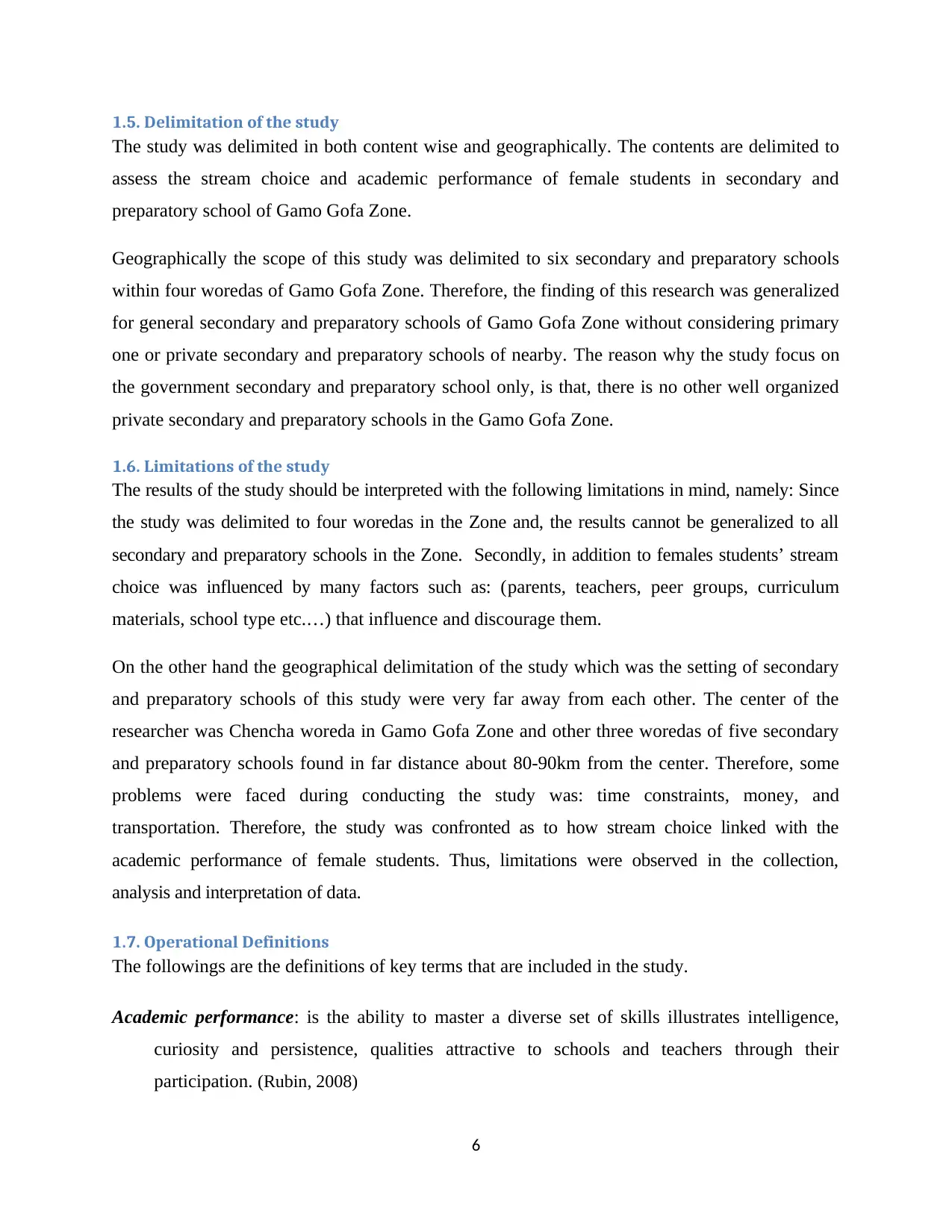
1.5. Delimitation of the study
The study was delimited in both content wise and geographically. The contents are delimited to
assess the stream choice and academic performance of female students in secondary and
preparatory school of Gamo Gofa Zone.
Geographically the scope of this study was delimited to six secondary and preparatory schools
within four woredas of Gamo Gofa Zone. Therefore, the finding of this research was generalized
for general secondary and preparatory schools of Gamo Gofa Zone without considering primary
one or private secondary and preparatory schools of nearby. The reason why the study focus on
the government secondary and preparatory school only, is that, there is no other well organized
private secondary and preparatory schools in the Gamo Gofa Zone.
1.6. Limitations of the study
The results of the study should be interpreted with the following limitations in mind, namely: Since
the study was delimited to four woredas in the Zone and, the results cannot be generalized to all
secondary and preparatory schools in the Zone. Secondly, in addition to females students’ stream
choice was influenced by many factors such as: (parents, teachers, peer groups, curriculum
materials, school type etc.…) that influence and discourage them.
On the other hand the geographical delimitation of the study which was the setting of secondary
and preparatory schools of this study were very far away from each other. The center of the
researcher was Chencha woreda in Gamo Gofa Zone and other three woredas of five secondary
and preparatory schools found in far distance about 80-90km from the center. Therefore, some
problems were faced during conducting the study was: time constraints, money, and
transportation. Therefore, the study was confronted as to how stream choice linked with the
academic performance of female students. Thus, limitations were observed in the collection,
analysis and interpretation of data.
1.7. Operational Definitions
The followings are the definitions of key terms that are included in the study.
Academic performance: is the ability to master a diverse set of skills illustrates intelligence,
curiosity and persistence, qualities attractive to schools and teachers through their
participation. (Rubin, 2008)
6
The study was delimited in both content wise and geographically. The contents are delimited to
assess the stream choice and academic performance of female students in secondary and
preparatory school of Gamo Gofa Zone.
Geographically the scope of this study was delimited to six secondary and preparatory schools
within four woredas of Gamo Gofa Zone. Therefore, the finding of this research was generalized
for general secondary and preparatory schools of Gamo Gofa Zone without considering primary
one or private secondary and preparatory schools of nearby. The reason why the study focus on
the government secondary and preparatory school only, is that, there is no other well organized
private secondary and preparatory schools in the Gamo Gofa Zone.
1.6. Limitations of the study
The results of the study should be interpreted with the following limitations in mind, namely: Since
the study was delimited to four woredas in the Zone and, the results cannot be generalized to all
secondary and preparatory schools in the Zone. Secondly, in addition to females students’ stream
choice was influenced by many factors such as: (parents, teachers, peer groups, curriculum
materials, school type etc.…) that influence and discourage them.
On the other hand the geographical delimitation of the study which was the setting of secondary
and preparatory schools of this study were very far away from each other. The center of the
researcher was Chencha woreda in Gamo Gofa Zone and other three woredas of five secondary
and preparatory schools found in far distance about 80-90km from the center. Therefore, some
problems were faced during conducting the study was: time constraints, money, and
transportation. Therefore, the study was confronted as to how stream choice linked with the
academic performance of female students. Thus, limitations were observed in the collection,
analysis and interpretation of data.
1.7. Operational Definitions
The followings are the definitions of key terms that are included in the study.
Academic performance: is the ability to master a diverse set of skills illustrates intelligence,
curiosity and persistence, qualities attractive to schools and teachers through their
participation. (Rubin, 2008)
6
⊘ This is a preview!⊘
Do you want full access?
Subscribe today to unlock all pages.

Trusted by 1+ million students worldwide
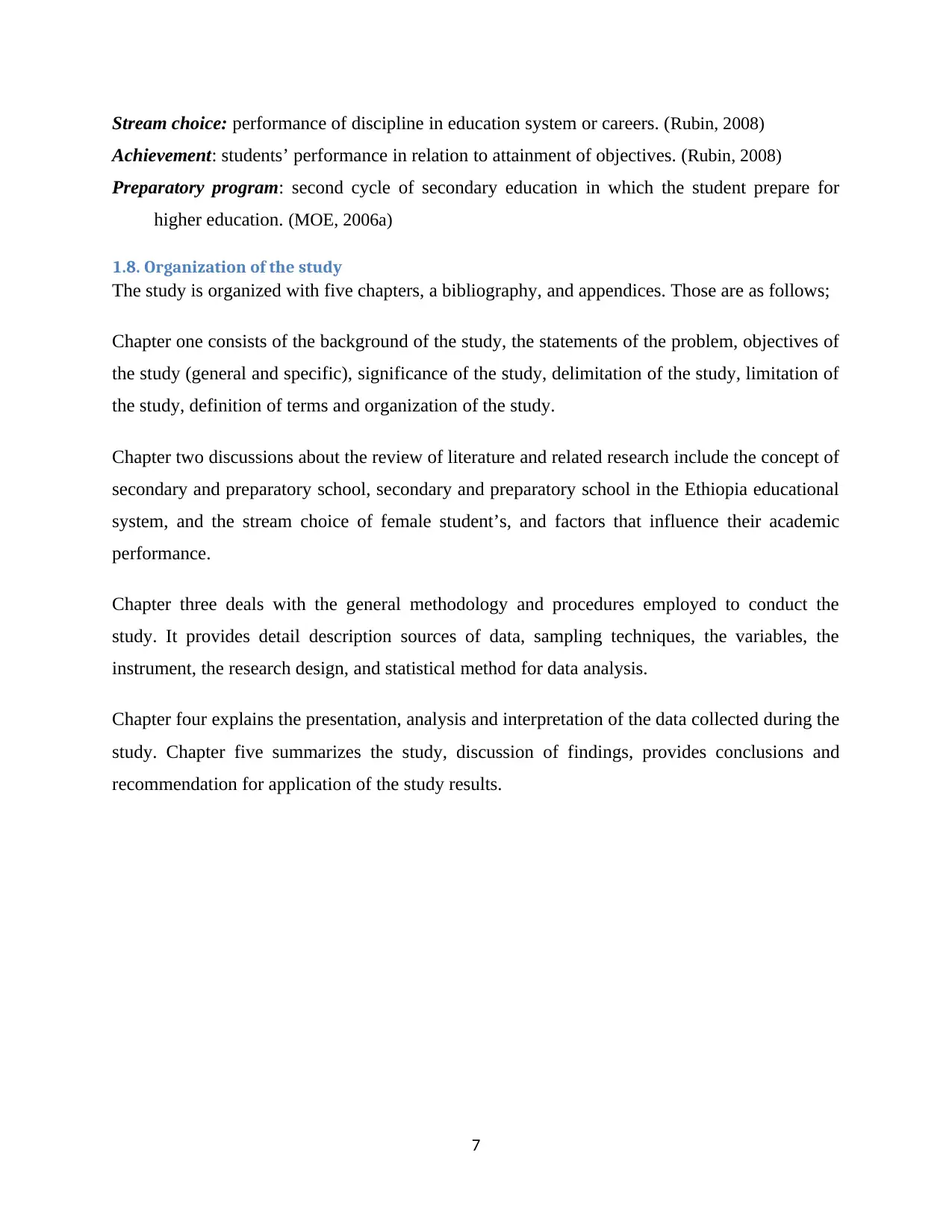
Stream choice: performance of discipline in education system or careers. (Rubin, 2008)
Achievement: students’ performance in relation to attainment of objectives. (Rubin, 2008)
Preparatory program: second cycle of secondary education in which the student prepare for
higher education. (MOE, 2006a)
1.8. Organization of the study
The study is organized with five chapters, a bibliography, and appendices. Those are as follows;
Chapter one consists of the background of the study, the statements of the problem, objectives of
the study (general and specific), significance of the study, delimitation of the study, limitation of
the study, definition of terms and organization of the study.
Chapter two discussions about the review of literature and related research include the concept of
secondary and preparatory school, secondary and preparatory school in the Ethiopia educational
system, and the stream choice of female student’s, and factors that influence their academic
performance.
Chapter three deals with the general methodology and procedures employed to conduct the
study. It provides detail description sources of data, sampling techniques, the variables, the
instrument, the research design, and statistical method for data analysis.
Chapter four explains the presentation, analysis and interpretation of the data collected during the
study. Chapter five summarizes the study, discussion of findings, provides conclusions and
recommendation for application of the study results.
7
Achievement: students’ performance in relation to attainment of objectives. (Rubin, 2008)
Preparatory program: second cycle of secondary education in which the student prepare for
higher education. (MOE, 2006a)
1.8. Organization of the study
The study is organized with five chapters, a bibliography, and appendices. Those are as follows;
Chapter one consists of the background of the study, the statements of the problem, objectives of
the study (general and specific), significance of the study, delimitation of the study, limitation of
the study, definition of terms and organization of the study.
Chapter two discussions about the review of literature and related research include the concept of
secondary and preparatory school, secondary and preparatory school in the Ethiopia educational
system, and the stream choice of female student’s, and factors that influence their academic
performance.
Chapter three deals with the general methodology and procedures employed to conduct the
study. It provides detail description sources of data, sampling techniques, the variables, the
instrument, the research design, and statistical method for data analysis.
Chapter four explains the presentation, analysis and interpretation of the data collected during the
study. Chapter five summarizes the study, discussion of findings, provides conclusions and
recommendation for application of the study results.
7
Paraphrase This Document
Need a fresh take? Get an instant paraphrase of this document with our AI Paraphraser
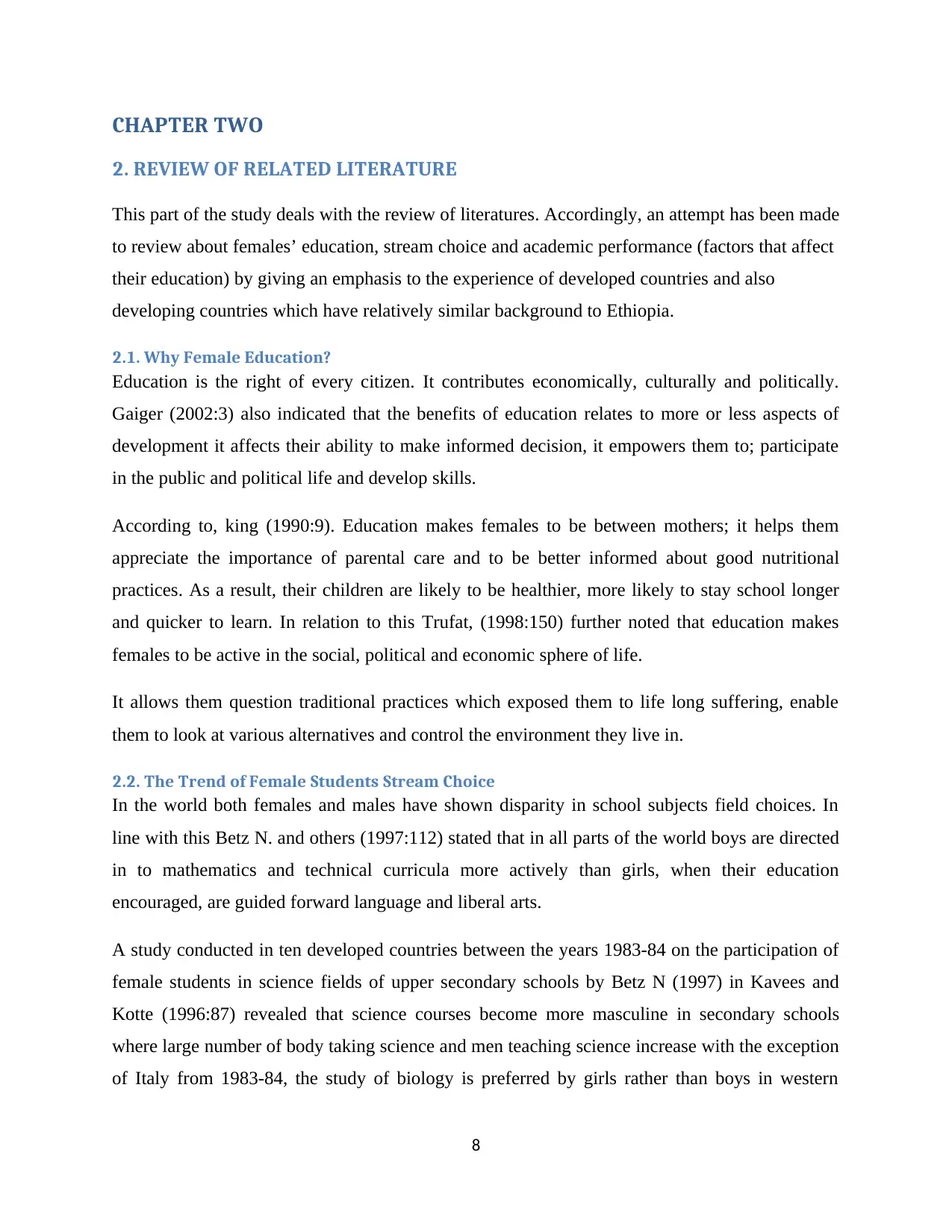
CHAPTER TWO
2. REVIEW OF RELATED LITERATURE
This part of the study deals with the review of literatures. Accordingly, an attempt has been made
to review about females’ education, stream choice and academic performance (factors that affect
their education) by giving an emphasis to the experience of developed countries and also
developing countries which have relatively similar background to Ethiopia.
2.1. Why Female Education?
Education is the right of every citizen. It contributes economically, culturally and politically.
Gaiger (2002:3) also indicated that the benefits of education relates to more or less aspects of
development it affects their ability to make informed decision, it empowers them to; participate
in the public and political life and develop skills.
According to, king (1990:9). Education makes females to be between mothers; it helps them
appreciate the importance of parental care and to be better informed about good nutritional
practices. As a result, their children are likely to be healthier, more likely to stay school longer
and quicker to learn. In relation to this Trufat, (1998:150) further noted that education makes
females to be active in the social, political and economic sphere of life.
It allows them question traditional practices which exposed them to life long suffering, enable
them to look at various alternatives and control the environment they live in.
2.2. The Trend of Female Students Stream Choice
In the world both females and males have shown disparity in school subjects field choices. In
line with this Betz N. and others (1997:112) stated that in all parts of the world boys are directed
in to mathematics and technical curricula more actively than girls, when their education
encouraged, are guided forward language and liberal arts.
A study conducted in ten developed countries between the years 1983-84 on the participation of
female students in science fields of upper secondary schools by Betz N (1997) in Kavees and
Kotte (1996:87) revealed that science courses become more masculine in secondary schools
where large number of body taking science and men teaching science increase with the exception
of Italy from 1983-84, the study of biology is preferred by girls rather than boys in western
8
2. REVIEW OF RELATED LITERATURE
This part of the study deals with the review of literatures. Accordingly, an attempt has been made
to review about females’ education, stream choice and academic performance (factors that affect
their education) by giving an emphasis to the experience of developed countries and also
developing countries which have relatively similar background to Ethiopia.
2.1. Why Female Education?
Education is the right of every citizen. It contributes economically, culturally and politically.
Gaiger (2002:3) also indicated that the benefits of education relates to more or less aspects of
development it affects their ability to make informed decision, it empowers them to; participate
in the public and political life and develop skills.
According to, king (1990:9). Education makes females to be between mothers; it helps them
appreciate the importance of parental care and to be better informed about good nutritional
practices. As a result, their children are likely to be healthier, more likely to stay school longer
and quicker to learn. In relation to this Trufat, (1998:150) further noted that education makes
females to be active in the social, political and economic sphere of life.
It allows them question traditional practices which exposed them to life long suffering, enable
them to look at various alternatives and control the environment they live in.
2.2. The Trend of Female Students Stream Choice
In the world both females and males have shown disparity in school subjects field choices. In
line with this Betz N. and others (1997:112) stated that in all parts of the world boys are directed
in to mathematics and technical curricula more actively than girls, when their education
encouraged, are guided forward language and liberal arts.
A study conducted in ten developed countries between the years 1983-84 on the participation of
female students in science fields of upper secondary schools by Betz N (1997) in Kavees and
Kotte (1996:87) revealed that science courses become more masculine in secondary schools
where large number of body taking science and men teaching science increase with the exception
of Italy from 1983-84, the study of biology is preferred by girls rather than boys in western
8
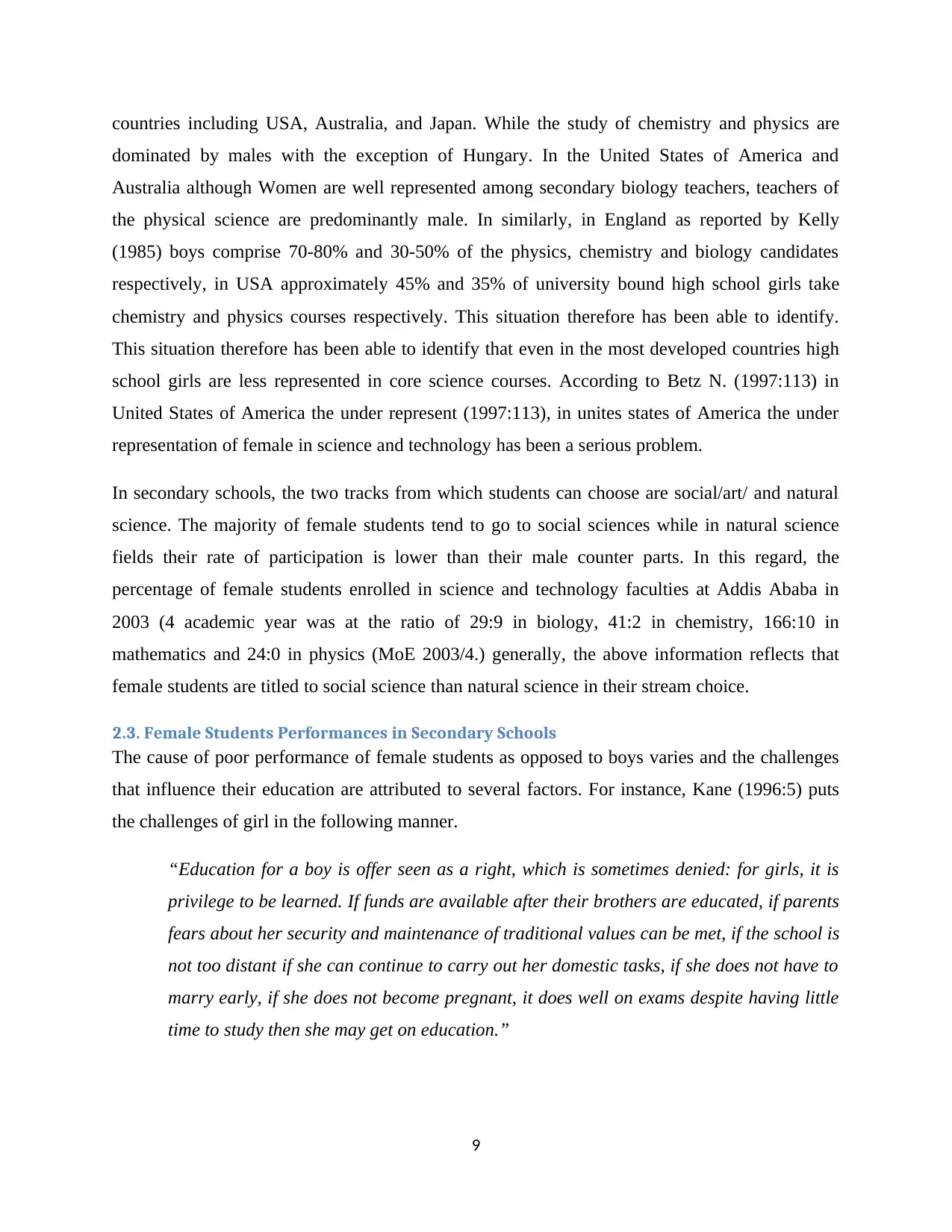
countries including USA, Australia, and Japan. While the study of chemistry and physics are
dominated by males with the exception of Hungary. In the United States of America and
Australia although Women are well represented among secondary biology teachers, teachers of
the physical science are predominantly male. In similarly, in England as reported by Kelly
(1985) boys comprise 70-80% and 30-50% of the physics, chemistry and biology candidates
respectively, in USA approximately 45% and 35% of university bound high school girls take
chemistry and physics courses respectively. This situation therefore has been able to identify.
This situation therefore has been able to identify that even in the most developed countries high
school girls are less represented in core science courses. According to Betz N. (1997:113) in
United States of America the under represent (1997:113), in unites states of America the under
representation of female in science and technology has been a serious problem.
In secondary schools, the two tracks from which students can choose are social/art/ and natural
science. The majority of female students tend to go to social sciences while in natural science
fields their rate of participation is lower than their male counter parts. In this regard, the
percentage of female students enrolled in science and technology faculties at Addis Ababa in
2003 (4 academic year was at the ratio of 29:9 in biology, 41:2 in chemistry, 166:10 in
mathematics and 24:0 in physics (MoE 2003/4.) generally, the above information reflects that
female students are titled to social science than natural science in their stream choice.
2.3. Female Students Performances in Secondary Schools
The cause of poor performance of female students as opposed to boys varies and the challenges
that influence their education are attributed to several factors. For instance, Kane (1996:5) puts
the challenges of girl in the following manner.
“Education for a boy is offer seen as a right, which is sometimes denied: for girls, it is
privilege to be learned. If funds are available after their brothers are educated, if parents
fears about her security and maintenance of traditional values can be met, if the school is
not too distant if she can continue to carry out her domestic tasks, if she does not have to
marry early, if she does not become pregnant, it does well on exams despite having little
time to study then she may get on education.”
9
dominated by males with the exception of Hungary. In the United States of America and
Australia although Women are well represented among secondary biology teachers, teachers of
the physical science are predominantly male. In similarly, in England as reported by Kelly
(1985) boys comprise 70-80% and 30-50% of the physics, chemistry and biology candidates
respectively, in USA approximately 45% and 35% of university bound high school girls take
chemistry and physics courses respectively. This situation therefore has been able to identify.
This situation therefore has been able to identify that even in the most developed countries high
school girls are less represented in core science courses. According to Betz N. (1997:113) in
United States of America the under represent (1997:113), in unites states of America the under
representation of female in science and technology has been a serious problem.
In secondary schools, the two tracks from which students can choose are social/art/ and natural
science. The majority of female students tend to go to social sciences while in natural science
fields their rate of participation is lower than their male counter parts. In this regard, the
percentage of female students enrolled in science and technology faculties at Addis Ababa in
2003 (4 academic year was at the ratio of 29:9 in biology, 41:2 in chemistry, 166:10 in
mathematics and 24:0 in physics (MoE 2003/4.) generally, the above information reflects that
female students are titled to social science than natural science in their stream choice.
2.3. Female Students Performances in Secondary Schools
The cause of poor performance of female students as opposed to boys varies and the challenges
that influence their education are attributed to several factors. For instance, Kane (1996:5) puts
the challenges of girl in the following manner.
“Education for a boy is offer seen as a right, which is sometimes denied: for girls, it is
privilege to be learned. If funds are available after their brothers are educated, if parents
fears about her security and maintenance of traditional values can be met, if the school is
not too distant if she can continue to carry out her domestic tasks, if she does not have to
marry early, if she does not become pregnant, it does well on exams despite having little
time to study then she may get on education.”
9
⊘ This is a preview!⊘
Do you want full access?
Subscribe today to unlock all pages.

Trusted by 1+ million students worldwide
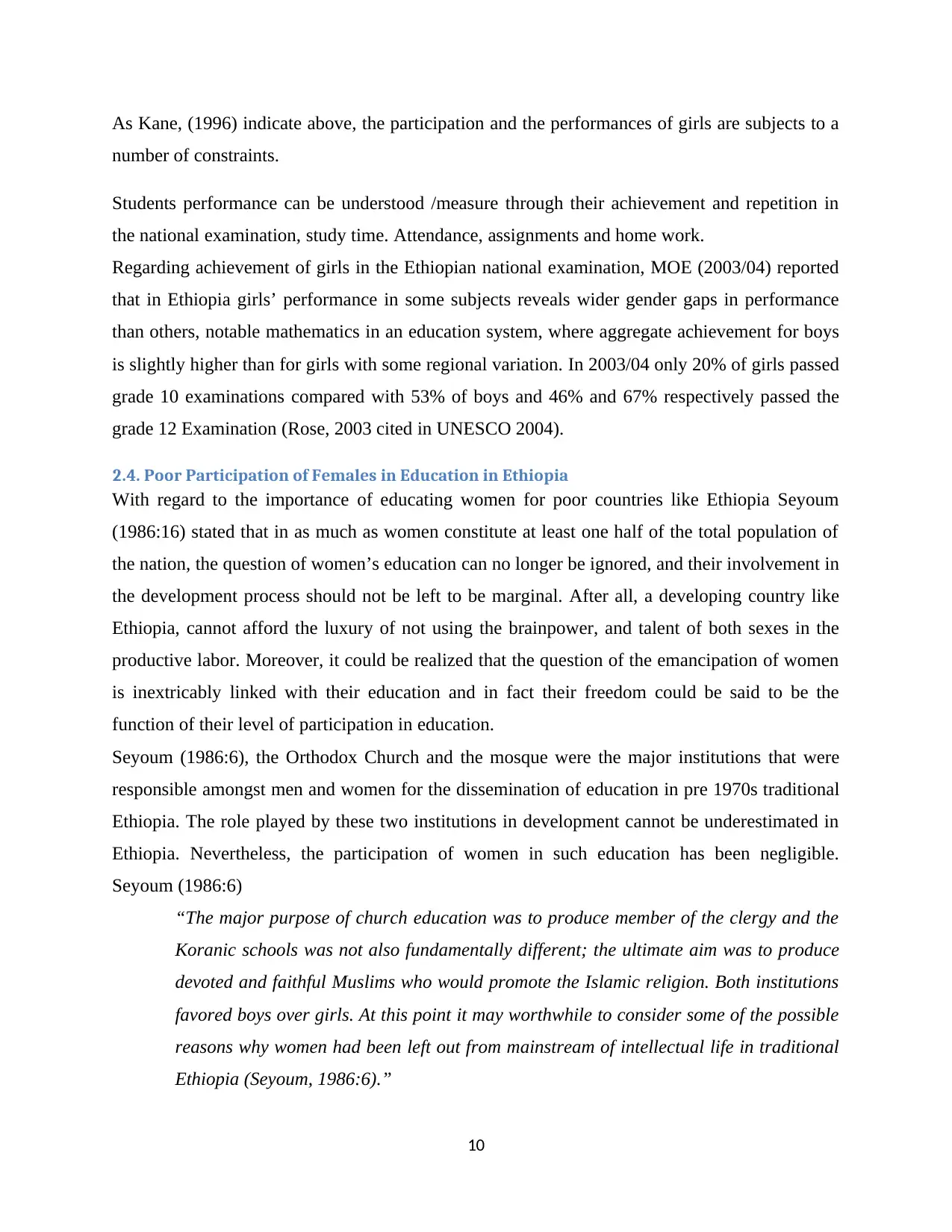
As Kane, (1996) indicate above, the participation and the performances of girls are subjects to a
number of constraints.
Students performance can be understood /measure through their achievement and repetition in
the national examination, study time. Attendance, assignments and home work.
Regarding achievement of girls in the Ethiopian national examination, MOE (2003/04) reported
that in Ethiopia girls’ performance in some subjects reveals wider gender gaps in performance
than others, notable mathematics in an education system, where aggregate achievement for boys
is slightly higher than for girls with some regional variation. In 2003/04 only 20% of girls passed
grade 10 examinations compared with 53% of boys and 46% and 67% respectively passed the
grade 12 Examination (Rose, 2003 cited in UNESCO 2004).
2.4. Poor Participation of Females in Education in Ethiopia
With regard to the importance of educating women for poor countries like Ethiopia Seyoum
(1986:16) stated that in as much as women constitute at least one half of the total population of
the nation, the question of women’s education can no longer be ignored, and their involvement in
the development process should not be left to be marginal. After all, a developing country like
Ethiopia, cannot afford the luxury of not using the brainpower, and talent of both sexes in the
productive labor. Moreover, it could be realized that the question of the emancipation of women
is inextricably linked with their education and in fact their freedom could be said to be the
function of their level of participation in education.
Seyoum (1986:6), the Orthodox Church and the mosque were the major institutions that were
responsible amongst men and women for the dissemination of education in pre 1970s traditional
Ethiopia. The role played by these two institutions in development cannot be underestimated in
Ethiopia. Nevertheless, the participation of women in such education has been negligible.
Seyoum (1986:6)
“The major purpose of church education was to produce member of the clergy and the
Koranic schools was not also fundamentally different; the ultimate aim was to produce
devoted and faithful Muslims who would promote the Islamic religion. Both institutions
favored boys over girls. At this point it may worthwhile to consider some of the possible
reasons why women had been left out from mainstream of intellectual life in traditional
Ethiopia (Seyoum, 1986:6).”
10
number of constraints.
Students performance can be understood /measure through their achievement and repetition in
the national examination, study time. Attendance, assignments and home work.
Regarding achievement of girls in the Ethiopian national examination, MOE (2003/04) reported
that in Ethiopia girls’ performance in some subjects reveals wider gender gaps in performance
than others, notable mathematics in an education system, where aggregate achievement for boys
is slightly higher than for girls with some regional variation. In 2003/04 only 20% of girls passed
grade 10 examinations compared with 53% of boys and 46% and 67% respectively passed the
grade 12 Examination (Rose, 2003 cited in UNESCO 2004).
2.4. Poor Participation of Females in Education in Ethiopia
With regard to the importance of educating women for poor countries like Ethiopia Seyoum
(1986:16) stated that in as much as women constitute at least one half of the total population of
the nation, the question of women’s education can no longer be ignored, and their involvement in
the development process should not be left to be marginal. After all, a developing country like
Ethiopia, cannot afford the luxury of not using the brainpower, and talent of both sexes in the
productive labor. Moreover, it could be realized that the question of the emancipation of women
is inextricably linked with their education and in fact their freedom could be said to be the
function of their level of participation in education.
Seyoum (1986:6), the Orthodox Church and the mosque were the major institutions that were
responsible amongst men and women for the dissemination of education in pre 1970s traditional
Ethiopia. The role played by these two institutions in development cannot be underestimated in
Ethiopia. Nevertheless, the participation of women in such education has been negligible.
Seyoum (1986:6)
“The major purpose of church education was to produce member of the clergy and the
Koranic schools was not also fundamentally different; the ultimate aim was to produce
devoted and faithful Muslims who would promote the Islamic religion. Both institutions
favored boys over girls. At this point it may worthwhile to consider some of the possible
reasons why women had been left out from mainstream of intellectual life in traditional
Ethiopia (Seyoum, 1986:6).”
10
Paraphrase This Document
Need a fresh take? Get an instant paraphrase of this document with our AI Paraphraser
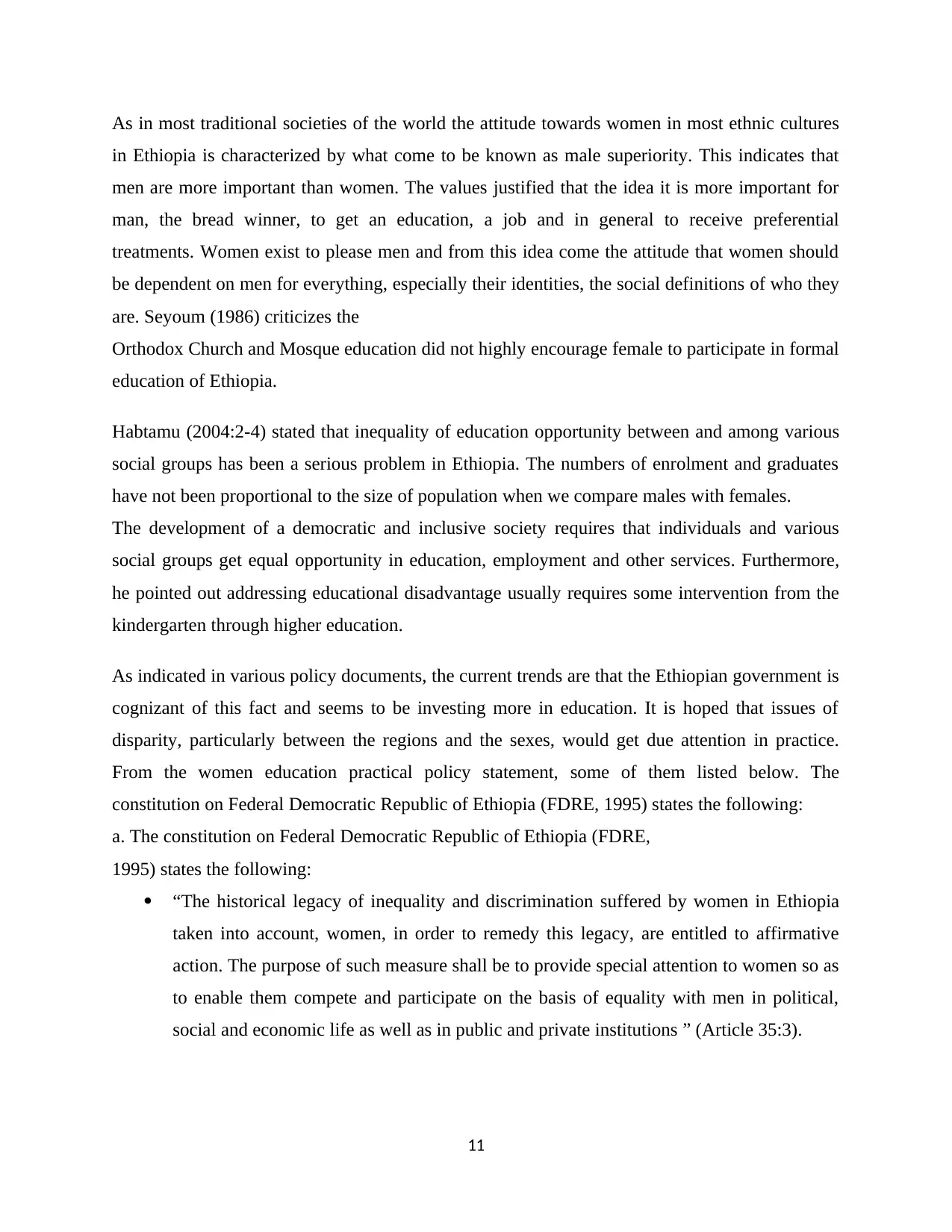
As in most traditional societies of the world the attitude towards women in most ethnic cultures
in Ethiopia is characterized by what come to be known as male superiority. This indicates that
men are more important than women. The values justified that the idea it is more important for
man, the bread winner, to get an education, a job and in general to receive preferential
treatments. Women exist to please men and from this idea come the attitude that women should
be dependent on men for everything, especially their identities, the social definitions of who they
are. Seyoum (1986) criticizes the
Orthodox Church and Mosque education did not highly encourage female to participate in formal
education of Ethiopia.
Habtamu (2004:2-4) stated that inequality of education opportunity between and among various
social groups has been a serious problem in Ethiopia. The numbers of enrolment and graduates
have not been proportional to the size of population when we compare males with females.
The development of a democratic and inclusive society requires that individuals and various
social groups get equal opportunity in education, employment and other services. Furthermore,
he pointed out addressing educational disadvantage usually requires some intervention from the
kindergarten through higher education.
As indicated in various policy documents, the current trends are that the Ethiopian government is
cognizant of this fact and seems to be investing more in education. It is hoped that issues of
disparity, particularly between the regions and the sexes, would get due attention in practice.
From the women education practical policy statement, some of them listed below. The
constitution on Federal Democratic Republic of Ethiopia (FDRE, 1995) states the following:
a. The constitution on Federal Democratic Republic of Ethiopia (FDRE,
1995) states the following:
“The historical legacy of inequality and discrimination suffered by women in Ethiopia
taken into account, women, in order to remedy this legacy, are entitled to affirmative
action. The purpose of such measure shall be to provide special attention to women so as
to enable them compete and participate on the basis of equality with men in political,
social and economic life as well as in public and private institutions ” (Article 35:3).
11
in Ethiopia is characterized by what come to be known as male superiority. This indicates that
men are more important than women. The values justified that the idea it is more important for
man, the bread winner, to get an education, a job and in general to receive preferential
treatments. Women exist to please men and from this idea come the attitude that women should
be dependent on men for everything, especially their identities, the social definitions of who they
are. Seyoum (1986) criticizes the
Orthodox Church and Mosque education did not highly encourage female to participate in formal
education of Ethiopia.
Habtamu (2004:2-4) stated that inequality of education opportunity between and among various
social groups has been a serious problem in Ethiopia. The numbers of enrolment and graduates
have not been proportional to the size of population when we compare males with females.
The development of a democratic and inclusive society requires that individuals and various
social groups get equal opportunity in education, employment and other services. Furthermore,
he pointed out addressing educational disadvantage usually requires some intervention from the
kindergarten through higher education.
As indicated in various policy documents, the current trends are that the Ethiopian government is
cognizant of this fact and seems to be investing more in education. It is hoped that issues of
disparity, particularly between the regions and the sexes, would get due attention in practice.
From the women education practical policy statement, some of them listed below. The
constitution on Federal Democratic Republic of Ethiopia (FDRE, 1995) states the following:
a. The constitution on Federal Democratic Republic of Ethiopia (FDRE,
1995) states the following:
“The historical legacy of inequality and discrimination suffered by women in Ethiopia
taken into account, women, in order to remedy this legacy, are entitled to affirmative
action. The purpose of such measure shall be to provide special attention to women so as
to enable them compete and participate on the basis of equality with men in political,
social and economic life as well as in public and private institutions ” (Article 35:3).
11
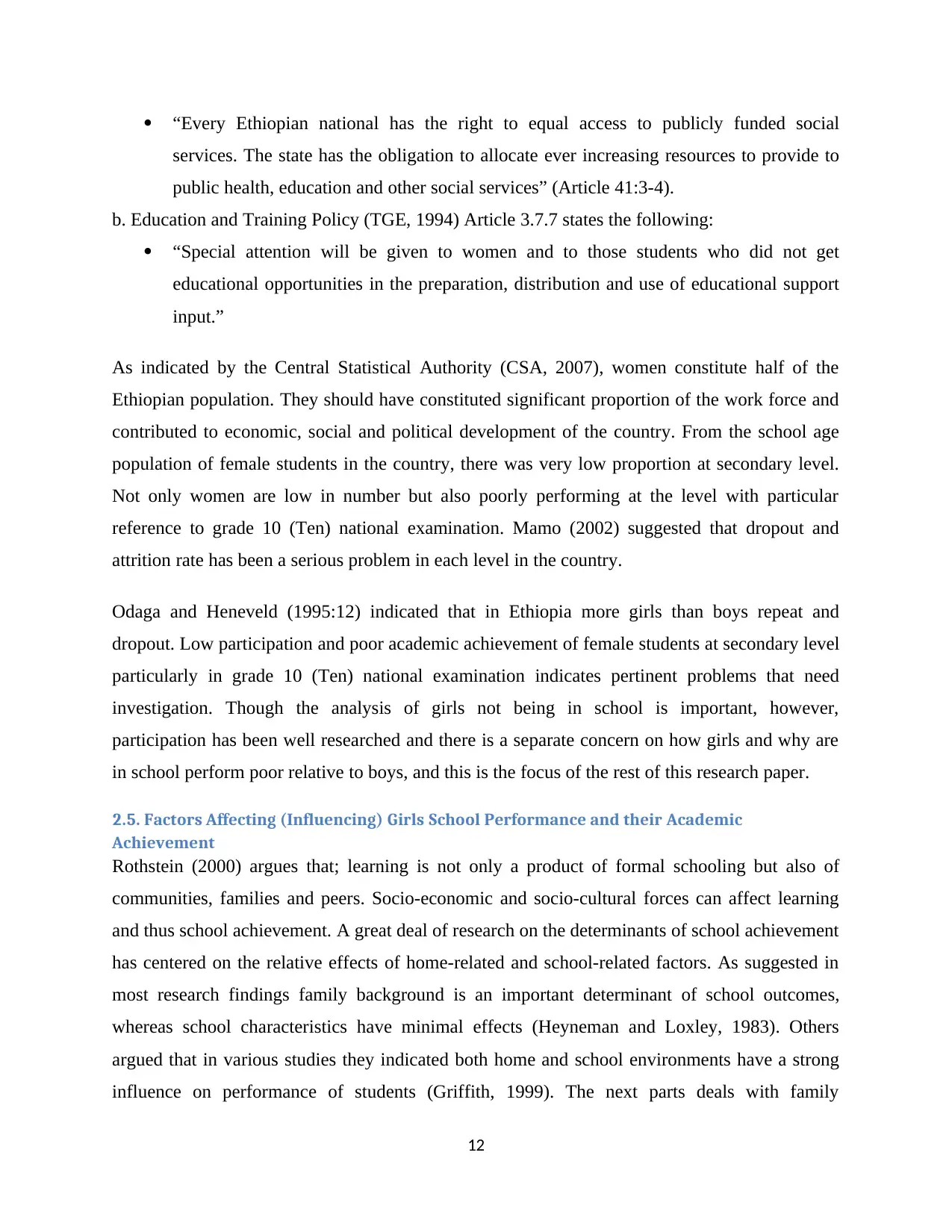
“Every Ethiopian national has the right to equal access to publicly funded social
services. The state has the obligation to allocate ever increasing resources to provide to
public health, education and other social services” (Article 41:3-4).
b. Education and Training Policy (TGE, 1994) Article 3.7.7 states the following:
“Special attention will be given to women and to those students who did not get
educational opportunities in the preparation, distribution and use of educational support
input.”
As indicated by the Central Statistical Authority (CSA, 2007), women constitute half of the
Ethiopian population. They should have constituted significant proportion of the work force and
contributed to economic, social and political development of the country. From the school age
population of female students in the country, there was very low proportion at secondary level.
Not only women are low in number but also poorly performing at the level with particular
reference to grade 10 (Ten) national examination. Mamo (2002) suggested that dropout and
attrition rate has been a serious problem in each level in the country.
Odaga and Heneveld (1995:12) indicated that in Ethiopia more girls than boys repeat and
dropout. Low participation and poor academic achievement of female students at secondary level
particularly in grade 10 (Ten) national examination indicates pertinent problems that need
investigation. Though the analysis of girls not being in school is important, however,
participation has been well researched and there is a separate concern on how girls and why are
in school perform poor relative to boys, and this is the focus of the rest of this research paper.
2.5. Factors Affecting (Influencing) Girls School Performance and their Academic
Achievement
Rothstein (2000) argues that; learning is not only a product of formal schooling but also of
communities, families and peers. Socio-economic and socio-cultural forces can affect learning
and thus school achievement. A great deal of research on the determinants of school achievement
has centered on the relative effects of home-related and school-related factors. As suggested in
most research findings family background is an important determinant of school outcomes,
whereas school characteristics have minimal effects (Heyneman and Loxley, 1983). Others
argued that in various studies they indicated both home and school environments have a strong
influence on performance of students (Griffith, 1999). The next parts deals with family
12
services. The state has the obligation to allocate ever increasing resources to provide to
public health, education and other social services” (Article 41:3-4).
b. Education and Training Policy (TGE, 1994) Article 3.7.7 states the following:
“Special attention will be given to women and to those students who did not get
educational opportunities in the preparation, distribution and use of educational support
input.”
As indicated by the Central Statistical Authority (CSA, 2007), women constitute half of the
Ethiopian population. They should have constituted significant proportion of the work force and
contributed to economic, social and political development of the country. From the school age
population of female students in the country, there was very low proportion at secondary level.
Not only women are low in number but also poorly performing at the level with particular
reference to grade 10 (Ten) national examination. Mamo (2002) suggested that dropout and
attrition rate has been a serious problem in each level in the country.
Odaga and Heneveld (1995:12) indicated that in Ethiopia more girls than boys repeat and
dropout. Low participation and poor academic achievement of female students at secondary level
particularly in grade 10 (Ten) national examination indicates pertinent problems that need
investigation. Though the analysis of girls not being in school is important, however,
participation has been well researched and there is a separate concern on how girls and why are
in school perform poor relative to boys, and this is the focus of the rest of this research paper.
2.5. Factors Affecting (Influencing) Girls School Performance and their Academic
Achievement
Rothstein (2000) argues that; learning is not only a product of formal schooling but also of
communities, families and peers. Socio-economic and socio-cultural forces can affect learning
and thus school achievement. A great deal of research on the determinants of school achievement
has centered on the relative effects of home-related and school-related factors. As suggested in
most research findings family background is an important determinant of school outcomes,
whereas school characteristics have minimal effects (Heyneman and Loxley, 1983). Others
argued that in various studies they indicated both home and school environments have a strong
influence on performance of students (Griffith, 1999). The next parts deals with family
12
⊘ This is a preview!⊘
Do you want full access?
Subscribe today to unlock all pages.

Trusted by 1+ million students worldwide
1 out of 100
Related Documents
Your All-in-One AI-Powered Toolkit for Academic Success.
+13062052269
info@desklib.com
Available 24*7 on WhatsApp / Email
![[object Object]](/_next/static/media/star-bottom.7253800d.svg)
Unlock your academic potential
Copyright © 2020–2025 A2Z Services. All Rights Reserved. Developed and managed by ZUCOL.




